
The NRPA Parks Snapshot provides the latest data on how park and recreation leaders from across the country are confronting the Coronavirus Disease 2019 (COVID-19) pandemic. I hope you find this information helpful as you make decisions at your agency during this uncertain time, while continuing to follow the guidance provided by your local and state governments and health officials, as well as the Centers for Disease Control and Prevention (CDC).
We will continue to provide weekly data from the NRPA Parks Snapshot survey, as state and local guidance and ordinances regarding COVID-19 are changing rapidly.
Among the key findings from the July 8-10 survey:
What's Open/What's Closed
As the summer progresses, we have seen an increased number of park and recreation professionals and their agencies opening more amenities to the public. This includes keeping open or opening all their trails (99 percent) and parks (local parks: 96 percent; regional parks: 97 percent).
Other amenities that agencies have fully opened across the nation include:
- Golf courses (96 percent)
- Dog parks (96 percent)
- Tennis courts (96 percent)
- Skateparks (94 percent)
- Community gardens (94 percent)
- Beaches for walking (86 percent)
- Campgrounds (85 percent)
- Outdoor sports fields (83 percent)
- Beaches for swimming (81 percent)
- Basketball courts (78 percent)
- Temporary restroom facilities (78 percent)
- Playgrounds (74 percent)
- Permanent restrooms at outdoor amenities (70 percent)
- Recreation centers (48 percent)
While more amenities and facilities are beginning to open, the following park and recreation amenities have remained closed at many agencies:
- Senior centers (77 percent)
- Splash pads (53 percent)
- Drinking fountains (51 percent)
- Indoor gyms (49 percent)
- Outdoor pools (42 percent)
Indoor Facilities
As noted above, more than half of all agencies have opened all of their recreation centers to the public. To help ensure these facilities are safe for visitors and staff, agencies are implementing the following strategies:
- Displaying signage warning of COVID-19 risks and informing of physical distancing practices (69 percent)
- Implementing environmental protective measures including installing plexiglass barriers, marking the floor to encourage physical distancing or conducting touchless transactions (62 percent)
- Installing additional hand sanitizing/washing stations to encourage healthy hygiene (59 percent)
- Establishing policies for face coverings for the public when using facilities (57 percent)
Plans for Positive Cases
Nine in ten park and recreation agencies have established formal plans in the event of a positive case of COVID-19 at programs and facilities or among staff. Steps being taken or steps being planned for include:
- Establishing standard operating procedures for all programs and facilities outlining how to handle a positive case (66 percent)
- Having a partnership with the local public health department to seek guidance and direction on managing a positive case (64 percent)
- Having a communications plan in place outlining how information will be shared with staff and volunteers (60 percent)
- Having a communications plan in place outlining how information will be shared with the public (52 percent)
- Maintaining up-to-date information on how your agency is prioritizing the health and safety of participants (51 percent)
Staff Well-Being
Park and recreation professionals are essential and ensuring staff physical and mental well-being is the highest priority of parks and recreation leaders. Health and well-being opportunities provided to park and recreation agency staff include:
- PPE and face coverings for employees in the field (90 percent)
- Altering workspaces to maintain physical distance (configuring partitions, rearranging furniture, installing signage, marking floors, installing directional markers, etc.) (79 percent)
- Requiring face coverings in the workplace (78 percent)
- Training employees on personal protective measures (hygiene, cleaning, cloth face coverings, use of PPE, stress management) (72 percent)
- Employee Assistance Programs (EAP) (72 percent)
Plans for the Fall
With summer already halfway over, park and recreation leaders are turning their thoughts to the services and programming offerings for this fall. Currently, most agencies’ fall plans are either on hold awaiting additional guidance or currently still scheduled but with a truncated offering. Offerings currently on hold awaiting additional guidance include:
- Sports leagues (contact) (49 percent)
- 5k races and other running/walking events (47 percent)
- Festivals/concerts (40 percent)
- Sports leagues (non-contact) (28 percent)
Few agencies have canceled fall programs with the exception of activities involving large groups, such as festivals, concerts and races. Fall activities that have been canceled include:
- Festivals/concerts (39 percent)
- 5k races and other running/walking events (23 percent)
- Childcare for children of the general public (16 percent)
In addition, here are highlights of the survey results from specific segments:
- Large metropolitan areas
- Small metropolitan areas and rural locales
- Agencies located in areas partially open
- Agencies located where all services are permitted by health authorities
The full results of the survey include verbatim comments shared by park and recreation leaders across the nation on their agencies’ experiences in confronting COVID-19. This is an uncertain time with many unanswered questions, and we encourage you to continue the conversation with your colleagues around how your agency is confronting COVID-19 on NRPA Connect.
For more information and to see results from additional surveys, visit NRPA's Parks Snapshot Surveys webpage.
For more information about NRPA’s response to COVID-19, as well as available resources for park and recreation professionals, please see our Coronavirus Disease 2019 (COVID-19) webpage.
Kevin Roth is Vice President of Research, Evaluation and Technology at NRPA.
Pictured above: Physical distancing sign in a park managed by the New York City Department of Parks and Recreation. Photo courtesy of Dreamstime.


